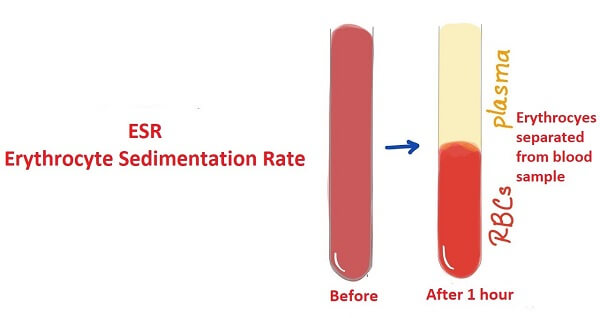What is the full form of ESRESR: Erythrocyte Sedimentation RateESR stands for Erythrocyte Sedimentation Rate. It is also referred to as a Sed Rate, or Westergren Sedimentation rate. Erythrocytes mean red blood cells. In this blood test, a sample of blood is taken in a test tube to measure how fast does the red blood cells settle at the bottom of the test tube. If the rate of the settling of the red blood cells is faster than normal, it means there is inflammation in the body. It can be due to certain health issues like an immune disorder, a sign of chronic diseases, or other medical conditions. What is the Purpose of this Test?This test helps to determine if there is any condition that is causing inflammation in your body. These conditions include inflammatory bowel disease, vasculitis or arthritis, etc. It may also b used to monitor the existing condition of a person. Blood testing in an ESR test is to measures how quickly red blood cells, or erythrocytes, separate from a blood sample that has been mixed with anti-clotting medication. A little sample of your blood will be placed in an upright tube for this test. After an hour, a lab expert will evaluate how quickly your red blood cells are falling to the tube's bottom. 
Red blood cells have a propensity to collect together if you have a disorder that results in inflammation or cell damage. As a result, they get heavier and settle more quickly. Your ESR increases as your red blood cells settle and deplete more quickly. A high ESR alerts your doctor that your body might be experiencing an active illness process. How the Test is AdministeredThis test requires a sample of blood. A health care professional will collect a blood sample in a vial or test tube from a vein on the inner part of the elbow or the back of the hand. The test estimates how quickly erythrocytes, or red blood cells, settle to the bottom of a long, thin tube. How to Get Ready for the ExamFor this test, no extra preparation is required. The Experience of the TestWhen the needle is inserted or goes out, you can experience a tiny pinch or sting. After the blood is drawn, you can experience some bruising or pain where the needle was inserted, but it goes away quickly. Why is the Test Done?A "sed rate" may be performed for the following reasons:
This test can be used to keep tabs on cancer or inflammatory illnesses. It is not employed to identify a particular illness. However, the test is helpful for identifying and
Standard Results For Adults Using the Westergren Method:Men under 50: less than 15 mm per hour Less than 20 mm/hr for men over the age of 50 Women under 50: less than 20 mm per hour Women over 50: less than 30 mm per hour For kids: 0 to 2 mm/hr for newborns 3 to 13 mm/hr from infancy until puberty mm/hr stands for millimeters per hour. Different laboratories may have slightly different normal value ranges. Discuss the significance of your particular test results with your healthcare professional. What Unusual Results Indicate?While an abnormal ESR may aid in the diagnosis, it cannot define a proper illness. Almost always, more testing is required to be certain about the health issue one might be experiencing. A higher ESR rate could also be seen in those who have:
What Could Affect the Findings of My Test?Your ESR can rise as a result of numerous non-disease factors. These consist of:
The immune system aids in defending the body from dangerous chemicals. When the immune system unintentionally targets and kills healthy body tissue, it is known as an autoimmune illness. People with autoimmune disorders frequently have ESR levels that are greater than usual. Typical autoimmune conditions include:
Very high ESR levels are associated with autoimmune or other illnesses that are less common, such as:
There are also several infections that could cause an elevated ESR rate, including:
Next TopicFull Form
|
 For Videos Join Our Youtube Channel: Join Now
For Videos Join Our Youtube Channel: Join Now
Feedback
- Send your Feedback to [email protected]
Help Others, Please Share










